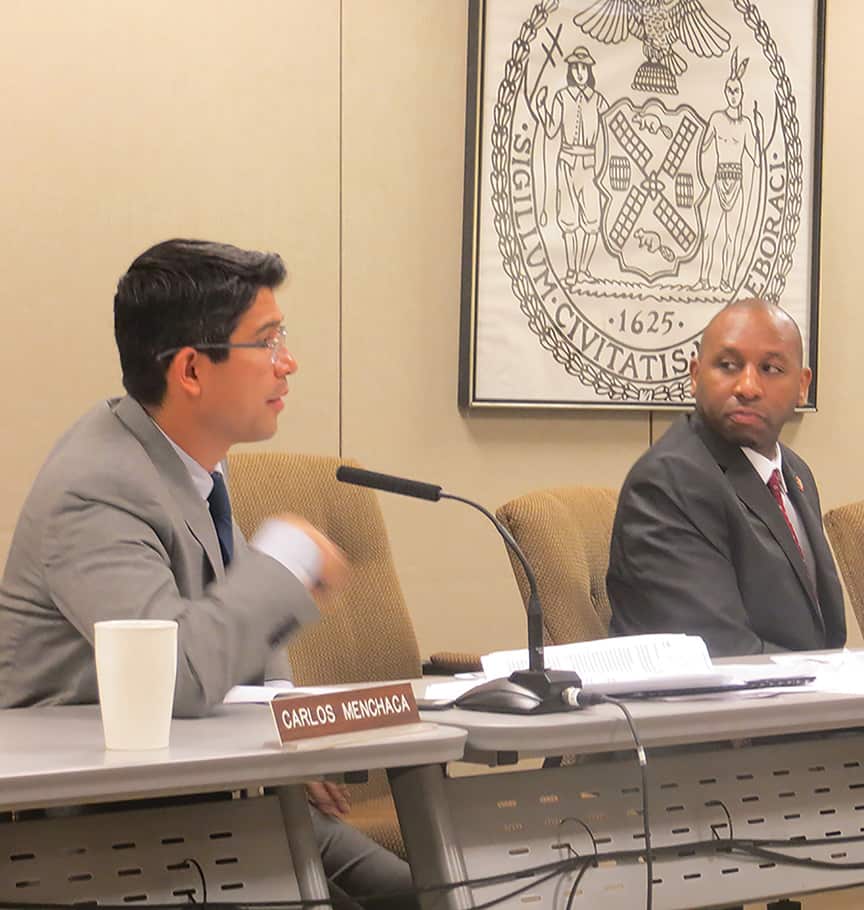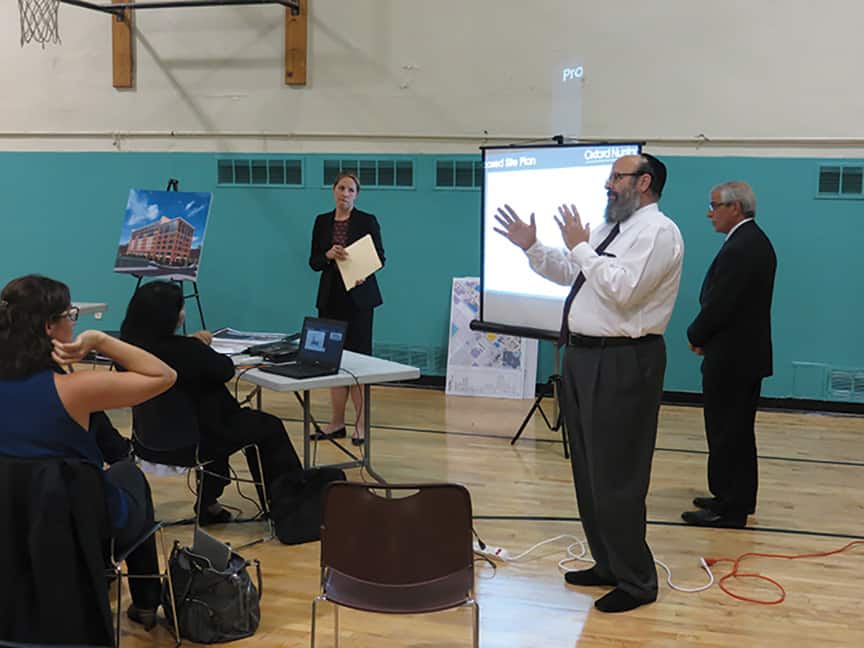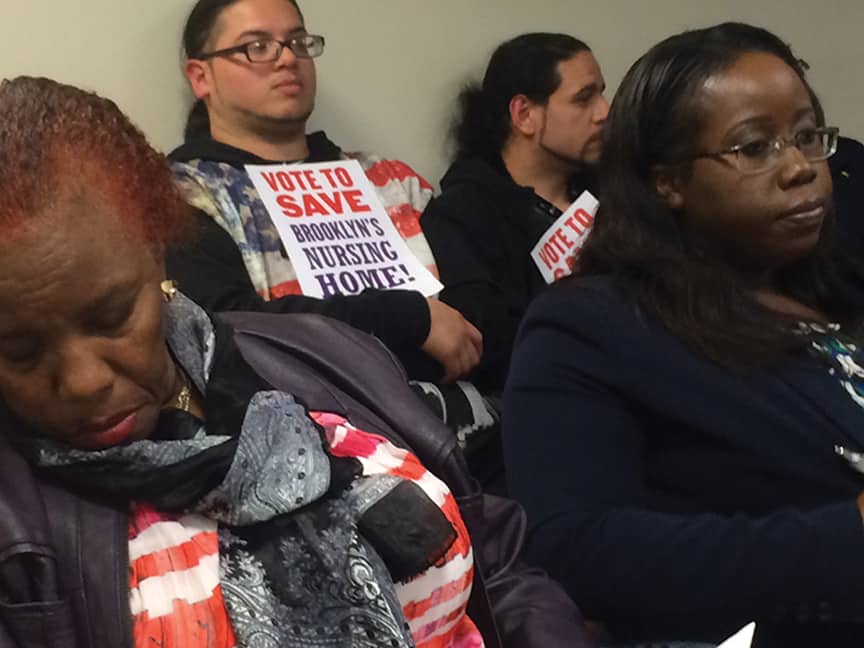Councilman Carlos Menchaca led a successful effort to defeat a proposed zoning change in May after hearing the community’s concerns about the relocation of a nursing home to Red Hook. The nursing home’s supporters included some of the largest development lobbyists in the city.

The Oxford Nursing Home is a for-profit healthcare facility located in Fort Greene. In 2003, they purchased almost a full block of land near the waterfront after the New York State Health Department told them that the Fort Greene location was no longer viable due to the age of the building. The land purchase and their promise to eventually relocate granted them waivers to continue operating in Fort Greene.
Last June, Oxford came to a Red Hook Civic Association meeting with lawyers, lobbyists and an architect to present their plan to the neighborhood.

Many at the meeting were shocked and surprised by the location of a medical facility in a floodplain, as well as its size. The proposed complex would have consisted of three 7-9 story buildings.
Most nearby buildings are only four or five stories tall.
Menchaca met with the developers in June 2015. “I expressed to them my concerns about maintaining manufacturing uses, locating vulnerable nursing home residents within a flood zone, the scale and context of the project, resilience, and impact on the community,” he told the Star-Revue. “Residents and business owners in Red Hook deserve responsible, sustainable growth in line with my long-standing commitment to preserving manufacturing zones, developing local employment, and preserving essential aspects of Red Hook’s neighborhood character.”
Menchaca also directed the developers to engage with the community.
After community input, Oxford made a slight alteration to their initial plan, and filed a Universal Land Use Review Procedure (ULURP) with the City Planning Commission. The plan was granted initial approval on November 24, 2015, which began an accelerated process starting at Community Board 6 (CB 6) and ending at the City Council.
CB 6 held a land use committee meeting in early December. Oxford, represented by Howard Weiss and Nora Martins of the firm Davidoff Hutcher & Citron LLP, brought in the Tenant Association Presidents of Red Hook East and West, the Brooklyn Chamber of Commerce, and members of union 1199 SEIU to testify in favor of the nursing home.
Davidoff Crutcher & Citron is an elite firm that specializes in government relations. Founder Sid Davidoff was a member of former NYC mayor John Lindsey’s administration, and is today close with Mayor Bill de Blasio, according to the NY Post. In January, they wrote, “Sid Davidoff and other politically connected lobbyists have seen their city-related business over the past two years skyrocket while scoring sweetheart deals and other positive results for clients after private sit-downs with the mayor, records show.”

The Chamber is a pro-business group organized to support business development. Union 1199 SEIU represents healthcare workers at Oxford, and has always been very politically connected.
Tenant Association presidents are often called upon for support of new projects coming into the neighborhood. However, their support does not necessarily represent the majority of their tenant’s voices.
Presidents Lillie Marshall of Red Hook West, and Frances Brown of Red Hook East, both supported GBX’s failed plan to build out property using dredged materials from the toxic Gowanus Canal; many of their tenants opposed the plan.

Other attendees of the December CB 6 land use meeting opposed the zoning change, including a number of local community leaders, residents, and business interests. John McGettrick is a long-time Red Hook activist and president of the Civic Association. He made his mark fighting against the city placing numerous waste-transfer stations in Red Hook in the 1990s. Jim Tampakis has operated a marine supply business on Richards Street for many years. Victoria Hagman operates a local real estate agency and is a member of CB 6. Robin Goeman is a Van Brunt Street resident and an elder-care attorney. All spoke out against the proposal.
Opponents of the nursing home said the large building was out of scale for the neighborhood. Despite Oxford’s guarantees, many doubted that the nursing home would supply care for local residents. In addition, manufacturing in the vicinity would be displaced, and the spot-zoning was illegal. Opponents also echoed Menchaca’s position that a flood zone is an illogical location for an elderly and vulnerable population.
While CB 6’s Land Use Committee voted against Oxford’s proposal, the full board later overturned that decision a week later. At this general board meeting, Oxford addressed residents’ complaints in a letter distributed to members. The letter was prepared by the nursing home’s lawyers and signing by Oxford’s owner, Barry Braunstein.
Jerry Armer, longtime CB 6 member, told the assembly that the letter had changed his position. He subsequently voted in Oxford’s favor. The majority of the board followed suit.
Less than two weeks later, Borough President Eric Adams held a public hearing at Borough Hall. Deputy Borough President Diana Reyna, a former city councilwoman who supported manufacturing jobs, chaired the meeting. She was soon joined by Adams, who made a special point to come to the hearing, just three days before Christmas.
Reyna asked why Oxford bought all that land when it wasn’t zoned for a nursing home – a question that the law firm could not quite answer.

IBZ removal
In 2012, the City was open to removing areas from IBZ zones upon request. In a letter dated July 27, 2012, Red Hook’s former councilwoman Sara Gonzalez sent a letter to the head of the IBZ commission. “Oxford has presented strong arguments for further modifying the IBZ boundaries to allow the residential rezoning of the balance of its site and the development of a new nursing home,” she wrote. “These include the fact that the nursing home will have at least 200 full-time employees, an operating budget in excess of $15,500,000, and a significant part of their purchasing is from local vendors and suppliers.
The proposed nursing home use at the property will not in any way erode the existing or potential manufacturing base in Red Hook or otherwise interfere with the objectives of the City’s manufacturing retention policy.” Oxford was additionally supported by then Borough President Marty Markowitz.
At this point, very few people in Red Hook knew anything of Oxford’s plans, or even that the lot, which lies between Van Brunt and Conover, and King and Sullivan, was slotted for any sort of construction. However, the lot across the street, an old warehouse was radically transformed into a cultural and community asset. Pioneer Works was established by artist Dustin Yellin, who had formerly occupied a studio down the street.
Pioneer Works is an eclectic artist space, museum, performance space, and catering hall, and has attracted many new visitors to the neighborhood. They have integrated themselves into the neighborhood in part by hosting some community fundraising events, including for PS 15 and the Red Hook Initiative.
Yellin also requested exclusion from the IBZ zone, as did McGettrick and Tampakis, on behalf of property owners along Van Brunt looking for commercial and residential uses of their buildings.
Below the radar
The nursing home remained out of the public eye until their plans were fully formulated and presented at the 2015 Civic Association meeting. By this time, Red Hook had undergone a devastating hurricane and elected a new council member, which changed things for Oxford.

Throughout the process, Menchaca stood firm in his original position – that placing a nursing home in a flood area would be a mistake.
Oxford kept up their strategy of using Red Hook’s low income population, the healthcare unions and the borough-wide business group to support their case.
The borough president, after extensive research by his land use specialist, Richard Bearak, declined to approve Oxford’s plan. At a later meeting arranged by Menchaca at the Red Hook Library,
Adams listened carefully and asked both sides probing questions.
Next City Planning (DCP) approved the proposal. The department is headed by de Blasio appointee Carl Weisbrod, who has worked in and out of city government for more than 35 years. He has also worked with real estate developers, most recently the consulting firm HR&A advisors, a source of many de Blasio hires, as well as a consultant for innumerable government projects.
Weisbrod and ten other DCP Commissioners voted for Oxford’s proposal; only Michelle de la Uz, Executive Director of Park Slope’s Fifth Avenue Committee, voted against it.
The ULURP’s final destination – the City Council – was next. Menchaca and his staff worked tirelessly to inform his fellow council members of the plan. It is customary for the Council to adhere to the inclination of the local council member on land use issues, but Menchaca, and Red Hook, was fighting a sophisticated opponent.
Davidoff persuaded 1199 SEIU members to make multiple phone calls to all the council members urging support for Oxford. Most councilmembers are Democrats; Democrats often align with unions. Davidoff also negotiated an op-ed by the union’s president, George Gresham, to printed in Crains.
Gresham called Menchaca’s decision “to not approve a new nursing home in Red Hook” a serious mistake. He continued, “We will continue to fight to one day make this bold, innovative, holistic plan a reality.”

47-2 vote
Menchaca held his ground and was able to get almost the whole Council to stand by his decision. The Oxford ULURP was defeated by a 47-2 vote.
Menchaca issued the following statement after the vote:
“The site at 141 Conover Street is inappropriate for serving vulnerable senior citizens with severe medical needs. This City must fulfill its commitments to building for long-term sustainability, fostering manufacturing jobs, and creating resilient communities. [The] vote was one of many critical decisions we will face about the placement of essential services. My colleagues and I are ready to assist the developer finding a safe alternate location so we can retain local jobs and increase medical services capacity.” resilient communities. Today’s vote was one of many critical decisions we will face about the placement of essential services. My colleagues and I are ready to assist the developer finding a safe alternate location so we can retain local jobs and increase medical services capacity.”








